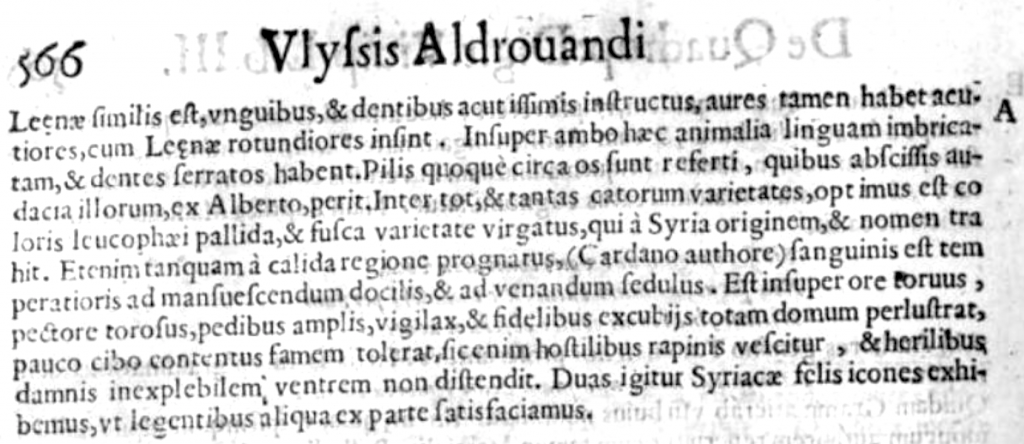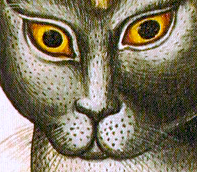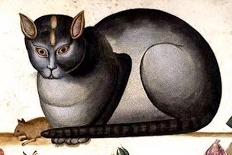The Chartreux is a natural breed of great antiquity. Evidence for the existence and characteristics of these blue cats of France can be traced back for hundreds of years.
A great deal of our present knowledge of this history comes from Jean Simonnet, whose book Le Chat des Chartreux (The Chartreux Cat) is listed in our reference library.

Origins
The earliest evidence associating the blue cats with France comes from the French poet Joachim du Bellay (1522 – 1560).
In 1558, du Bellay wrote a famous poem about a little gray cat named Belaud that he had befriended while living in Rome. The poem itself is quite delightful, praising Belaud’s rodent hunting talent as well as the beauty of his features, and listing many details which are reminiscent of our Chartreux of today. Belaud clearly reminds du Bellay of the cats of home, except that he is not completely gray like those cats (he has white markings on his belly):
Donques Belaud premièrement
Ne fut pas gris entièrement,
Ni tel qu’en France on les voit naître …
First of all, Belaud
was not entirely gray
unlike those that are born in France …
We can therefore infer from the poem that the presence of solid gray (blue) cats in France was common knowledge in du Bellay’s time, around 1550.
Where did these blue cats come from? Many authors in recent times have suggested a link to the “Cat of Syria,” described by Ulisse Aldrovandi (1522-1607).
Aldrovandi was an Italian scholar and naturalist, later considered by Linnaeus and Buffon to be the father of natural history studies. He taught logic and philosophy at the University of Bologna, and became the first professor of natural sciences there. Aldrovandi’s vast writings included hundreds of books and papers, although only a few were published during his lifetime. We learn about the Cat of Syria from Aldrovandi’s work, De Quadrupedibus digitatis viviparis libri tres. The text below is taken from an edition published in 1637.
“… Among so many and such a number of varieties of cats, there is one which is streaked with a diversity of pale and dark ash gray colors which is originally from Syria for which it was named… its breed is well tempered, and it is ready for the hunt. For the most part it has a rounded muzzle, a muscular chest and strong paws. It is vigilant and loyal to its master. It looks after the entire house, is content with little food to satisfy its hunger; moreover it feeds itself with captured oddities and thus fills its stomach not to the detriment of its master’s purse.”



This description of the Cat of Syria is reminiscent in many ways of later descriptions of Chartreux, including the physical description and praise for its fine temperament and hunting ability.
As for the description of this cat as “streaked with a diversity of pale and dark ash gray colors,” it is possible that Aldrovandi may have been describing a gray cat which came in both tabby and solid varieties. Two engravings are included with the original text, one showing tabby stripes, and the other showing small marks all over the cat which could indicate fur texture. A full color illustration from a later edition of this work (pictured above) shows a gray cat with faint stripes on the tail (a common feature of solid blue-gray cats), and vivid orange-copper eyes. A mouse is also shown in the illustration, emphasizing this cat’s utility in rodent hunting.
First mentions of the Chartreux by name
For the first mention of the Chartreux cat by name, we must skip forward in time to the Dictionnaire universel of Jacques Savary des Brûlons (1657–1716). During his life, Savary des Brûlons was the Inspector General for the French king at the Paris Customs. In the course of his work, Savary compiled a list of types of objects and terminology used in commerce, which he eventually developed into a comprehensive trade dictionary. After Savary’s death, the work was completed by his brother Louis-Philémon, and finally published as the Dictionnaire universel de commerce, d’histoire naturelle & des arts & métiers in 1723.


“CHARTREUX: The common name for a type of cat which has a blue coat. Furriers do business with their pelts.”
“Cats are of different colors. Among them are white, black, gray, red; white & black, white & gray, black & red, red & white; and black, red, & white ones which are called tricolored because of their three colors.
In addition, there are a few that are bluish. This last type is called Chartreux because of the monks of this name who owned the first of the breed.”
Savary’s dictionary entries on Chartreux and Cat give us several important pieces of information, summing up for us the common knowledge about Chartreux cats at the beginning of the 18th century:
- These cats were considered to be “blue” rather than gray. Note that Savary distinguishes blue cats from gray cats; perhaps the gray ones were tabbies.
- Their pelts were traded by furriers. As Savary was a customs inspector, this would have been the primary reason the breed would have come to his attention.
- The blue cats were relatively rare, described by Savary as only “a few” among all the various colors of cats, although there must have been enough of them to produce pelts for the fur trade.
- It was believed at the time that these cats had been raised by the Carthusian monks, and that this association was the reason the cats were called Chartreux.
Monastery cats?

We see from Savary that Chartreux cats were associated with the Carthusian monks from at least the beginning of the 18th century. Later authors repeated many versions of this story. One legend states that a monk of the Carthusian order carried one of the blue cats from South Africa home to France. Others have speculated that the blue cats traveled with knights returning from the Crusades, who brought them from mountainous regions in the East to the French monasteries.

Stories of the “monastery cats” have accumulated many charming details over the years. Chartreux cats are known to be particularly quiet, so some say that they “took the vow of silence” with the monks. Some Chartreux cats even have a peculiar habit of sitting up on their back legs and holding their paws together in a pose that makes them appear to “pray.”
Indeed, these cats would have been excellent companions for the monks, with their calm and devoted temperament, and renowned ability to hunt rats and mice. It is no wonder that the legend has persisted for centuries.
Historians today believe that these legends are unlikely to be true. Although monks did keep cats, there is no evidence that this breed was developed by monks, or raised by them in any deliberate way. In 1972, the Prior of the Grand Chartreuse searched the archives of the monastery, and wrote that “As for the subject of a breed of cat which had been of use by the Grand Chartreuse, our records stand silent. Nothing lets us assume that a breed of this type of cat has been utilized in any epic of our long history.”
After doing more research, Simonnet came up with a more prosaic explanation for the name of the Chartreux cat, which takes us back to the Dictionnaire of Savary des Brûlons.

“CHARTREUX. The common name for a type of cat which has a blue coat. Furriers do business with their pelts. See CAT.
CHARTREUX. One calls Pile des Chartreux a type of wool which they bring from Spain to use in the finest wool products. See WOOL.”
We see that the name Chartreux, in addition to being applied to the cat, was also used for a particularly fine type of wool. Savary goes on to explain that the finest types of wool available for the manufacture of fine clothing come from Spain, and that amongst these, the two very best are the Pile des Chartreux and the wool of the Jesuits.
Simonnet tells us, “It is quite possible that because of the soft and slightly wooly character of the fur, the cat was given the same name as a well-known wool, the Pile des Chartreux. As only the fur of the blue-gray cats presented this characteristic, the name was reserved for the furs as well as the animals of this color. This method of transferring a name is very common in the French language, especially in matters of fashion.”
